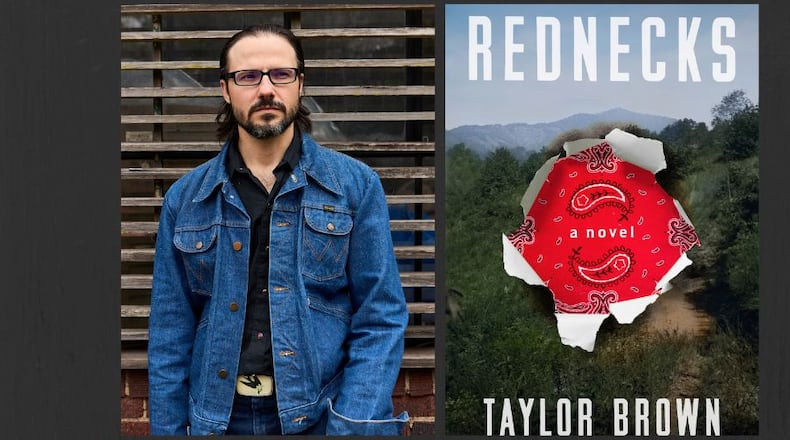The fight to unionize America’s coal industry culminated in a cataclysmic clash in 1921 between 10,000 Appalachian coal miners and 3,000 law enforcement and civilian coal supporters. The Battle of Blair Mountain is still ranked as both the largest armed uprising since the Civil War and the largest labor revolt in U.S. history. This tumultuous time period is brought to vibrant, palpable life in “Rednecks,” Savannah author Taylor Brown’s propulsive work of historical fiction that vividly re-imagines this stormy slice of history.
Brown’s story opens deep in a West Virginia coal mine in 1920 using the broad strokes of a collective voice to build the world the coal miners are fighting against. Forced to “breathe a black dust, explosive, which swirls through the cramped, yellow light,” the men work dawn to dusk in dank caves with nothing but red bandannas to filter the coal dust from their lungs.
An explosion kills 21 people, and the two survivors are less fearful of death than the company’s unfavorable reaction to unionization. The coal companies have locked miners into a dependent relationship the workers are powerless to shake.
Coal miners are forced to work under conditions “more dangerous than armed services in the Great War, are paid not in legal tender but company scrip, housed not in personal homes but company camps” and receive no compensation for death or dismemberment. Any attempt to improve conditions through unionization results in termination — which leads to eviction, impacting a miner’s entire family.
Two of Brown’s most endearing characters live out the eviction nightmare, illustrating the personal cost of America’s “Coal Wars.” Dr. Domit “Moo” Muhanna is a character inspired by Brown’s great-grandfather. Both are Kentucky doctors who emigrated from Lebanon in the 19th century. Dr. Moo makes a house call to drain the dropsy (edema) from the swollen feet of Miss Beulah Hugham, a 70-year-old widow who spends her days darning socks on the porch of her grandson’s company cabin.
One rainy afternoon, a member of the Baldwin-Felts agency — civilian detectives serving as coal-company enforcers — picks up Miss Beulah in her rocking chair and ejects her onto the street. Her grandson, WWI veteran “Big” Frank Hugham, has been fired for joining the United Mine Workers of America labor union and the eviction is in retaliation. Dr. Moo and the Hughams are fictional characters who interact with individuals and events Brown has plucked from the annals of history, like the Baldwin-Felts agents, and infused with personality and vitality.
Animosity mounts in the town of Matewan when historical figure Police Chief Sid Hatfield, a supporter of his coal-mining neighbors, is involved in a shootout now known as the Matewan Massacre. When the dust settles, Matewan’s mayor and two Baldwin-Felts agents are dead, and Sid is arrested for the murders, drawing a firm line in the “us against them” mentality that fuels what comes.
As Brown’s narrative continues, another real-life figure emerges — Mary “Mother” Jones, a famous union organizer and activist known as “the most dangerous woman in America” due to her success in organizing miners against coal companies.
More than 80 years old when she appears in Brown’s tale, Mother Jones is worn out from fighting and feels “heartsore, thin-boned and fleshy, in need of rest.” Nevertheless, she persists and rallies the terminated miners to join forces with neighboring union members and fight for their rights. Yet the coal company’s legal power halts the miners’ every attempt to improve their lives.
Nobody feels this worse than Big Frank as he faces far more catastrophic consequences for union activism than his eviction. Detained by the police, he isn’t arrested but is imprisoned in the jailhouse basement where he’s beaten by Baldwin-Felts agents. They drive Big Frank into the woods, beat him again and leave him for dead. But he survives and goes on to play a pivotal role as one of the fictional “Bad Seven,” former Great War infantry fighters who lead the resistance.
As tensions escalate between the striking miners and greedy coal companies, Dr. Moo, Miss Beulah, Big Frank, Chief Hatfield and Mother Jones move through the historical events leading up to the Battle of Blair Mountain. Brown rotates through a number of other point-of-view characters as well and occasionally returns to the collective voice to tell his tale of survival.
One thing that remains consistent despite the shifting perspective is the violence and brutality inflicted upon the coal miners and their families. In the author’s note, Brown writes that the term redneck was “originally used in the popular media to denigrate an Appalachian working class uprising as backwards, uneducated and dangerous.” Nothing could have driven home the division pitting American citizens against each other more than the U.S. military’s deployment to Blair Mountain to stop the rebellion.
“Rednecks” concludes in a blazing showdown as former servicemen Big Frank and the Bad Seven are forced to choose between firing on active military or surrendering their cause. Taylor Brown creates a compelling environment in which miners are forced to decide how much humanity they’re willing to relinquish to keep fighting for their rights.
FICTION
“Rednecks”
by Taylor Brown
St. Martin’s Press, 320 pages, $29
AUTHOR EVENT
Taylor Brown. In Conversation with Chuck Reece. 7 p.m. May 28. Cash bar. Presented by Writers at the Wrecking Bar and A Cappella Books. The Marianna Room at the Wrecking Bar Brewpub, 292 Moreland Ave., Atlanta. 404-681-5128, acappellabooks.com
About the Author
Keep Reading
The Latest
Featured



